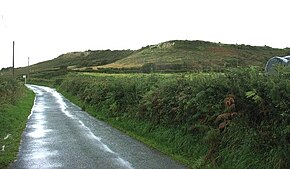
Bwrdd Arthur (Welsh for 'Arthur's Table'), also known as Din Sylwy, is a 164-metre (538 ft) flat-topped limestone hill on the island of Anglesey, in Wales. Located on the eastern end of Red Wharf Bay, some 3 kilometres north west of Llangoed, it is noteworthy from the evidence of pre-historic occupation and as a Site of Special Scientific Interest designated for its botanical interest.
The tiny medieval church of St Michael is on the eastern side of the hill fort.
Botany
[edit]The site has both calcareous heath and limestone exposures which between them support plant communities including western gorse Ulex gallii, common rockrose Helianthemum nummularium, pale St. John's wort Hypericum montanum, Frog orchid Coeloglossum viride, ivy broomrape Orobanche hederae and the nationally rare hoary rockrose Helianthemum canum.[1]
Archaeology
[edit]The whole site, which is in private ownership, is a scheduled monument and is believed to have been occupied as a significant hill fort both before and during the Roman invasion.[2]
References
[edit]- ^ "Site of Special Scientific Interest Citation – Anglesey – Bwrdd Arthur" (PDF). Natural Resources Wales. Retrieved 4 November 2023.
- ^ "Din Sylwy or Bwrdd Arthur Hillfort, Llanddona". Gwynedd Archaeological Trust. Retrieved 4 November 2023.
53°18′39″N 4°07′24″W / 53.31089°N 4.1232°W
Well, that’s interesting to know that Psilotum nudum are known as whisk ferns. Psilotum nudum is the commoner species of the two. While the P. flaccidum is a rare species and is found in the tropical islands. Both the species are usually epiphytic in habit and grow upon tree ferns. These species may also be terrestrial and grow in humus or in the crevices of the rocks.
View the detailed Guide of Psilotum nudum: Detailed Study Of Psilotum Nudum (Whisk Fern), Classification, Anatomy, Reproduction